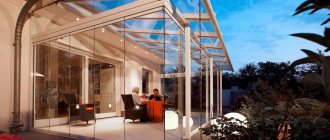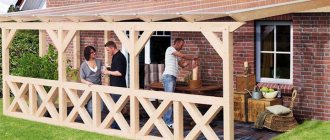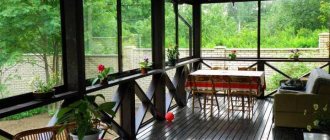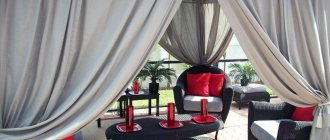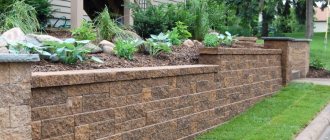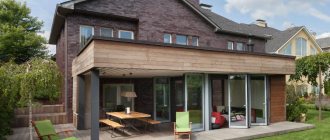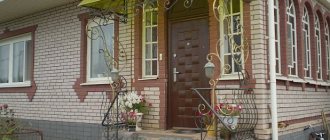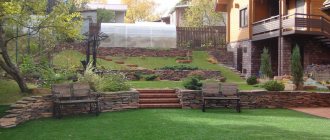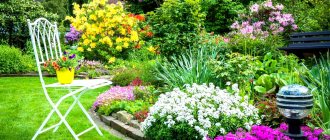Suitcase Lacase, Plastic, 52 cm, 30 l
2724 ₽ More details
Drill-driver DEKO GCD12DU3 Li-ion, 1x1.5Ah, Replaceable battery, 12 V, 32 Nm, 1 battery
1697 ₽ More details
Wedding Shoes
In this article we have to figure out how a veranda differs from a terrace. Both of these designs are very popular in cottage construction and country houses.
What is the difference between a terrace and a veranda
The main difference between a terrace and a veranda is the absence of windows and walls. A terrace, in its essence, is a flooring organized both as a direct extension of the space of the house and outside it - for example, on a hill. The terrace can be located under a canopy on poles or have no roof at all. This is an open area for which not only lighting is important, but also a system for removing excess moisture during rains. If you add at least a couple of full walls to the terrace and glaze it, this building will already fall under the category of “veranda” or gazebo (if the building is remote from the house).
A veranda is an enclosed space that is an extension of the house. With a simultaneous design, a common foundation is laid for the veranda and the house. The veranda is made as glazed as possible to gain access to daylight, but at the same time remain sheltered from precipitation and wind. Verandas can be unheated, as well as with a heating system, which will allow it to be used in the cold months.
Both architectural structures can be built after the house is built. Often people think about organizing an outdoor space in order to be able to relax comfortably on the street. In order for the extension to turn out with a successful layout, before construction it is worth deciding what problems it will solve in practice. From this they plan the area and purchase materials for the project.
conclusions
Let's summarize:
- So, a terrace is always an open building. The veranda can be made closed, it requires the presence of walls, a canopy and a roof, while the terrace can only have a fence - for example, a railing;
- It follows from this that heating can be installed on a closed veranda during the cold season, which cannot be said about the terrace, which is only suitable for summer;
- The veranda is always an extension to the main building and cannot exist separately. While the terrace can be located at a distance, most often even at some elevation. In some cases, the terrace is even located on the roof of the building to save space on the site.
Materials for building verandas and terraces
Depending on the type of building, we select the materials that will be used for the foundation, foundation, cladding, and finishing.
Terraces may differ in the type of foundation and have several levels. They may have different designs and, as a result, use different cladding. The veranda also receives a foundation depending on the characteristics of the soil. If the extension was built under the main structure, then it is worth understanding that since the veranda is lighter than the main structure, shrinkage may occur unevenly.
Regardless of the style, all materials used must be moisture-resistant, resistant to fungus and insects, and maintain their hardness and appearance when exposed to sunlight and temperature changes.
- Wood is natural and popular with most owners of suburban areas. Oak, teak, larch. Needs timely, annual treatment against mold and woodworms. These rocks are resistant to temperature changes, durable, and retain an attractive appearance.
- Natural stone, limestone and sandstone are used for cladding terraces and the lower part of the veranda. The use of stone in decoration puts additional load on the foundation and walls; this must be taken into account when designing.
- Ceramic tiles, porcelain tiles, clinker tiles - help to get a beautiful, non-slippery floor covering that is not afraid of precipitation, frost and scorching sun.
- Polycarbonate is a modern alternative to glazing. Allows you to make durable canopies that let in enough light. Polycarbonate is durable enough to withstand rain, hail and large amounts of snow.
- For budget options, siding, metal profiles, and flexible tiles can be used.
When choosing materials, the stylistic decision of the project and design features are taken into account. When installing a terrace, it is also important to take into account the features of the landscape. Even complex terrain can be turned into a cozy multi-level space.
Functionality of terraces and verandas
Owners can use home extensions in different ways. Some limit themselves to organizing a green corner, while others use a terrace or veranda as a relaxation area and dining area in the warm season. On the terraces you can also organize BBQ areas, fireplaces, and barbecues.
- Thanks to the presence of a roof, the terrace can become a shelter when it rains. Even if the weather turns bad, this will not affect the quality of your vacation. In country houses, terraces also become the basis for installing garden swings and even organizing Jacuzzis and outdoor pools.
- The veranda is a great place to place upholstered furniture, creating a corner of comfort almost in the open air. Large panoramic windows or floor-length French glazing allow you to enjoy the scenery, but still remain sheltered in case of wind or rain.
In order to competently build a project, you need to clearly understand: how many people will gather on the site, whether there will be children, what kind of leisure time will be offered to guests and household members. All this directly affects the distribution of zones, load calculations and the choice of materials for further construction. For example, you may be planning an outdoor living area with a table and wicker chairs, or you will have an area with a hearth or fireplace and will need fire-resistant coating for the floors and walls.
Photos of terraces
Terrace with transparent roof
Wooden terrace
Terrace-canopy
Wooden terrace with transparent roof
Simple terrace
Light terrace with stone floor
Mini house with terrace
Modern house with many terraces
Furniture for decorating terraces and verandas
For decorating summer areas, furniture that is not afraid of humidity, sun and temperature changes is popular. The peculiarity of outdoor furniture is that it consists of a durable frame base and is complemented by removable soft cushions and covers. Fabrics are treated with moisture-repellent impregnations. The frame is made of wood, wicker, rattan plastic - light but durable. Popular products made from artificial rattan are weaving from thin PVC strips. The main thing is to choose high-quality products that will not deform in the sun and emit unpleasant odors.
Garden furniture can easily stand outdoors all summer, but for the winter it will have to be moved indoors. It can be cleaned and even washed. The main thing is to follow the manufacturer's recommendations.
Popular for terraces and verandas:
- sofas and armchairs - can be placed around the fireplace;
- frameless furniture in covers impregnated from dust and water;
- dining sets - table and chairs, benches, stools and “beach” bar counters with high chairs;
- hanging sofas, swings, armchairs;
- kitchens, if there is a barbecue area, with a hood, cabinets and drawers for dishes and equipment.
Of course, one cannot help but use shelves, stands and stands for decorative landscaping. Hanging flowerpots are an integral part of summer areas. Racks and pillars can become the basis for draperies made of organza, linen and other fabrics that can shade the bright summer sun.
If it is assumed that children will play on the terrace or veranda, then additional swings, a table tennis table, and play and sports corners are installed. Boxes for toys, several shelves for magazines and books can also be located here.
Purpose of the veranda
Before we talk about how a veranda differs from a terrace, let’s briefly consider the purpose of the extension.
- Initially it was understood that this was an unheated utility room, that is, additional space for the building. Here you can place household items. And to make it look neat, they make cabinets and racks to place things.
- The extension serves as a protective barrier against the penetration of cold, heat on a hot day, and precipitation; dirt from the street does not rush into the hallway.
- The sound insulation of the façade zone of a permanent building is improved.
It is advisable to install larger windows so that the part adjacent to the facade is not too dark during the day. Since the lighting here will be provided by a second light (through the extension).
In modern construction, many owners want to have a heated veranda so they can use it at any time of the year. They insulate the walls, install plastic windows, heating devices or heated floors, double insulated entrance doors with a vestibule. Then any ideas are possible for interior decoration. The decoration of walls, ceilings, and floors is done as in a living room.
Housewives bring a lot of flowers into a warm room, creating a home greenhouse. It is appropriate to place a table in the extension, and the owner and a friend can play a game of chess, watch football, and talk about exciting topics. Before comparing the difference between a veranda and a terrace, let’s find out what a terrace is.
Popular style solutions for terraces and verandas
In this case, they try to make the extensions so as to support the general concept of the facade of the house and the design of the local area. To form a concept, a set of basic elements is used that sets the direction of the design idea.
Eco style
Natural materials dominate in decoration and furniture. Brick is selected, ceilings and flooring must be made of wood. Brick fencing posts are one of the characteristic features of an eco-style terrace. They also prefer textiles made from linen, cotton, and other natural fabrics.
Mediterranean style
To use it, it is not necessary to have a house on the banks of a river or pond. The combination of white and blue colors will refresh the atmosphere. Floors and walls are in universal white and beige shades. It looks like wood, limestone and marble bleached by the sun and sea. White furniture and textiles in majolica shades will complete the picture.
The main disadvantages of buildings
The enclosed nature of the veranda does not allow you to completely relax outside, even if you open all the windows. And the price of construction is several times higher than when constructing a terrace.
The terrace is suitable for relaxation only in good weather, and even a little rain can completely ruin the evening. In addition, you need to constantly take out and bring in furniture and dishes so that rain and snow do not damage them.
What to choose for yourself is everyone’s business; the main thing is to approach construction with soul. Then your vacation will be a pleasure.
Baroque
A luxury style that demands space and sophistication. Colors of chocolate, burgundy and greenery, finished with marble and parquet. Baroque is characterized by smooth lines - no sharp corners when choosing furniture.
Rustic, Provence, country
For lovers of the rustic style, you can offer country, Provence, rustic - styles that transfer you to a simple country atmosphere. Bold and lively country, lavender Provence, rough rustic - all of them are based on a preference for wood, forged elements, rustic paraphernalia and natural textiles. Provence is the most delicate of the presented directions; the rustic style is rough and brutal. The country direction occupies an intermediate position in terms of dynamics in interior solutions.
Modern, contemporary
A couple of areas where functionality and practicality of the furnishings are a common thread. Modern architecture is combined with a homely, cozy atmosphere. Modern designs allow the use of not only natural finishing materials, but also their imitations.
HOW TO DECORATE THE OUTSIDE
How to decorate a recreation area? Decorate with live plants. It is appropriate to make a border of flowering shrubs around the terrace, and plant flower beds under the windows of the veranda. Add a hedge or pergola to keep prying eyes out.
Vases and pots with flowers, tub plants or dwarf trees. All this will give the veranda or terrace comfort and set the mood for relaxation. Just don't overdo it! After all, an unnecessary pile of branches and leaves takes up a lot of space and is therefore annoying.
Lighting can also become an interesting, elegant and extraordinary element of decor. Hang outdoor lamps that fit into the overall style. If you like to “get twilight” in the evenings, eye-catching spot lighting in the garden will come in handy.
It would be nice to surround the terrace with a fence. If the height of its decking is a meter or more above the ground, the fence is vital for security purposes. But even with a low floor it will be beneficial. It will protect from the wind, curious neighbors and decorate the entire structure. The variety of fence designs is great - from a wooden lattice - a pergola with plants (vegetables or flowering ones), to a forged miracle with dragons.
